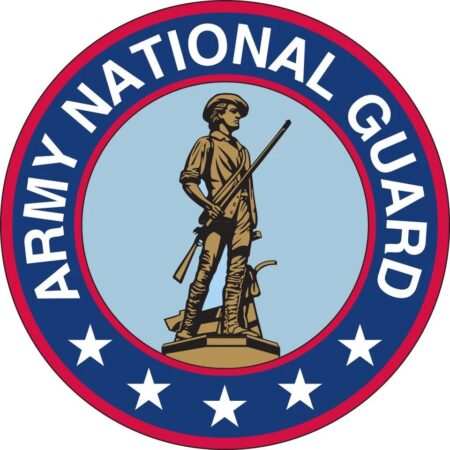The Minute Man depicted in the Army National Guard logo is meant to represent Isaac Davis. He was killed on April 19th, 1775 leading his troops at the Battle of Concord. The logo is an artwork of the statue erected to honor him


Isaac Davis (February 23, 1745 – April 19, 1775) was a gunsmith and a militia officer who commanded a company of Minutemen from Acton, Massachusetts, during the first battle of the American Revolutionary War.
In the months leading up to the Revolution, Davis set unusually high standards for his company in terms of equipment, training, and preparedness. His company was selected to lead the advance on the British Regulars during the Battle of Concord because his men were entirely outfitted with bayonets. During the American advance on the British at the Old North Bridge, Davis was among the first killed and was the first American officer to die in the Revolution.
Word of the British movement reached Acton just before dawn on April 19, most likely delivered by Dr. Samuel Prescott, a resident of Concord and one of the Sons of Liberty. As the alarm spread, the Acton Minutemen began to gather at Davis’s home. While waiting for others to arrive, the men made paper cartridges and some powdered their hair with flour so as to appear more like gentlemen when they met the British in battle. As the Minutemen prepared, Davis’s wife noticed that he seemed especially somber and said very little. As some of his men joked about getting shot at by a British soldier, Davis rebuked them, reminding them that some of them would soon be killed.
Davis formed up his company and ordered them to march at about 7 a.m. According to his wife and other witnesses, shortly after stepping off, Davis ordered his company to halt, then returned to his front door to tell his wife, “Take good care of the children.”
Soon after crossing into Concord, the Acton company passed the farm of Colonel James Barrett who commanded the provincial troops in Concord that morning. A small detachment of British soldiers were searching Barrett’s farm for supplies, and Davis considered attacking them. His orders, however, were to muster with the rest of the provincial militia and Minutemen near the Old North Bridge by the Concord River. He then diverted his company off the road, avoiding the British at Barrett’s farm and marching past a tavern belonging to a Widow Brown.
A boy named Charles Handley, who lived at Widow Brown’s Tavern, saw Davis’s company pass the tavern. He recalled many years later that a fifer and drummer played a song called “The White Cockade”, a reference to the white ribbon worn on their bonnets by Scots revolutionaries during The Jacobite rebellion of 1745. Tradition persists that this was Davis’s favorite marching song, but there is little evidence to support this notion. There is also a tradition that the Acton musicians played the White Cockade later when Davis’s company led the advance on the British at the Old North Bridge, although this too is not supported by primary source accounts.
Davis’s company reached the area of the Old North Bridge at approximately 9 a.m. Several other companies of militia and Minutemen, consisting of about 500 men from Concord, Lincoln, and Bedford, had already gathered on a small hill overlooking the bridge. Approximately 100 British Regulars occupied the bridge.
Shortly after Davis arrived, Barrett called a council of the officers present to determine whether or not to attack the Regulars at the bridge. In Concord, the majority of the British force was searching for supplies, but they found little. When they decided to burn some wooden gun carriages they discovered, the provincials near the Old North Bridge saw the smoke and thought the British were burning the town. Barrett then made the decision to attack the soldiers holding the bridge.
Davis’s company had taken their designated position at the left of the provincial line. This would have placed the Acton company in the rear of the attack when the line advanced. The company in the lead would have been Captain David Brown’s company from Concord. When Barrett asked Brown if he would lead the attack, Brown responded that he would rather not. Knowing that Davis’s company was well equipped with bayonets and cartridge boxes, Barrett asked Davis if his company would lead the advance. Several slight variations of Davis’s response have been recorded. His response is most often given as, “I have not a man that is afraid to go.” Following Barrett’s orders, Davis then moved his company to the right of the line.
Around 10:30, the provincials faced to the right and advanced on the Old North Bridge in a column of two men abreast. At the head of the column was Davis, Major John Buttrick of Concord, and Lt. Col. John Robinson of Westford. Barrett remained behind on the hill, cautioning his men as they marched by him not to fire first. The British at the bridge, watching the provincials approach, were surprised to see, as one soldier later said, that they “advanced with the greatest regularity”.
When the provincials were within about 75 yards of the bridge, the Regulars fired a few warning shots. Luther Blanchard, the fifer from Acton, was hit and wounded by one of these warning shots. The British then fired a disorganized volley. Isaac Davis was shot through the heart. Private Abner Hosmer of Acton was also killed in this volley. Seeing these casualties, Buttrick commanded, “Fire, fellow soldiers, for God’s sake fire!” and the provincials returned fire, causing the British to immediately retreat back to Concord.

